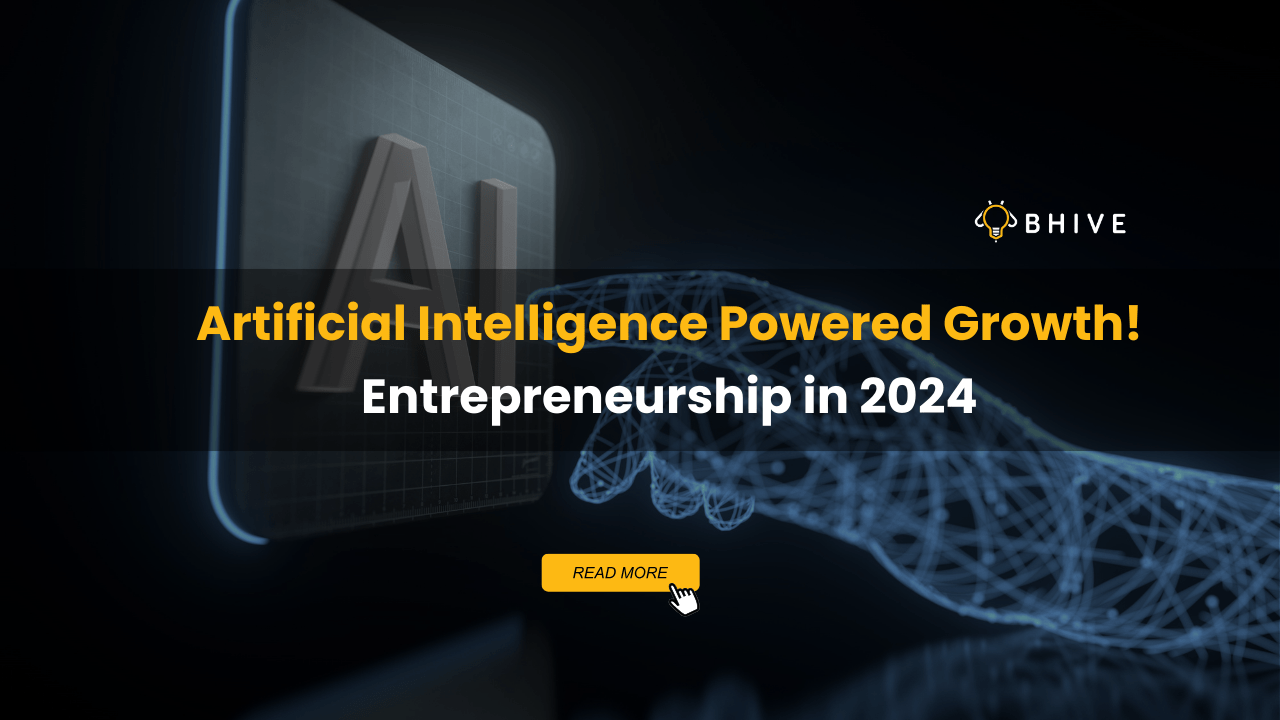Artificial Intelligence Powered Growth: Entrepreneurship in 2024

In 2024, the landscape of entrepreneurship is significantly shaped by the integration of advanced technologies, and Artificial Intelligence (AI) plays a pivotal role in revolutionizing the way businesses operate and grow. Beyond operational efficiency, AI analytics aids entrepreneurs in optimizing resource allocation. This includes workforce management, inventory control, and investment decisions, ensuring that resources are allocated where they will have the most significant impact. AI-powered systems enable seamless interactions across multiple channels, from websites to social media platforms. This ensures consistent and personalized engagement, regardless of the customer’s chosen communication channel. Let’s understand in this detailed exploration of BHIVE Workspace how AI can assist your entrepreneurial journey in the workspace. Keep reading!
Data-Driven Decision Making
AI Analytics Tool
In 2024, the significance of AI analytics tools for entrepreneurs extends to various crucial aspects of decision-making:
- Holistic Insight Generation: AI analytics platforms not only analyze structured data but also excel in handling unstructured data, such as social media sentiment and customer reviews. Entrepreneurs gain a holistic understanding of market dynamics, consumer sentiment, and industry trends.
- Dynamic Strategy Formulation: With AI’s ability to process real-time data, entrepreneurs can dynamically adjust their strategies. Whether responding to sudden market shifts or capitalizing on emerging opportunities, AI enables a more agile and responsive approach to strategy formulation.
- Personalized Customer Experiences: AI analytics delves deep into individual customer preferences and behaviours. Entrepreneurs can use this insight to personalize interactions, recommend products/services, and enhance overall customer experiences, fostering loyalty and satisfaction.
- Continuous Learning and Improvement: Machine learning algorithms embedded in AI analytics tools continuously learn from new data. This iterative learning process allows entrepreneurs to refine their models, predictions, and strategies over time, adapting to evolving market conditions.
- Strategic Innovation: AI analytics can uncover opportunities for innovation by identifying gaps in the market or areas where disruptive technologies can be applied. Entrepreneurs can leverage these insights to stay at the forefront of industry trends and drive strategic innovation within their businesses.
- Global Market Understanding: For entrepreneurs operating in the global market, AI analytics provides a comprehensive understanding of diverse markets and cultural nuances. This insight is invaluable for crafting strategies that resonate with different audiences and navigating the complexities of international business.
Customer Engagement and Personalization
AI-powered chatbots and Virtual Assistants
- Instant Customer Support: AI-driven chatbots provide instant responses to customer inquiries, ensuring round-the-clock support. This immediacy enhances customer satisfaction by addressing queries promptly, leading to positive customer experiences.
- Personalized Recommendations: By analyzing customer behaviour and preferences, AI-powered systems can offer personalized product or service recommendations. This level of customization creates a more tailored and engaging experience for each customer.
- Efficient Issue Resolution: Chatbots equipped with natural language processing capabilities can efficiently handle routine customer issues. This not only resolves problems promptly but also allows human support teams to focus on more complex concerns, improving overall issue resolution efficiency.
- Data-Driven Insights: AI captures and analyzes customer interactions, providing valuable insights into consumer behaviour. Entrepreneurs can leverage these insights to understand customer needs better, fine-tune marketing strategies, and adapt offerings to align with evolving preferences.
- Enhanced User Experience: AI-powered virtual assistants enhance the overall user experience by guiding customers through processes, offering real-time assistance, and making interactions more intuitive. This fosters a positive perception of the brand and contributes to long-term customer loyalty.
- Time and Resource Efficiency: Automated responses from chatbots save time for both customers and entrepreneurs. This efficiency allows entrepreneurs to allocate resources more strategically, focusing on core business activities that require human intervention.
- Scalability: AI-driven customer engagement tools are highly scalable. As the business grows, these systems can handle increasing volumes of customer interactions without a proportional increase in resources, ensuring a seamless and efficient customer experience during periods of expansion.
Marketing and Advertising Optimization
AI-Based Marketing Platforms
- Consumer Behavior Analysis: AI analyzes vast datasets of consumer behaviour, identifying patterns and trends that may go unnoticed through traditional methods. This in-depth understanding allows entrepreneurs to create targeted marketing campaigns aligned with actual consumer preferences.
- Predictive Analytics: AI’s predictive capabilities forecast future trends based on historical data. Entrepreneurs can proactively adjust their marketing strategies, ensuring they stay ahead of the curve and capitalize on emerging opportunities.
- Personalized Content Delivery: By leveraging AI, entrepreneurs can personalize content delivery to individual consumers. This includes tailoring advertisements, emails, and promotions based on the consumer’s preferences, behaviours, and past interactions with the brand.
- Optimized Ad Placement: AI algorithms analyze various factors to determine the most effective placement for advertisements. This includes selecting the right channels, platforms, and timing to maximize visibility and engagement, ultimately improving the return on advertising investment.
- A/B Testing Automation: AI automates the A/B testing process, rapidly experimenting with different ad creatives, messages, or strategies. This iterative testing allows entrepreneurs to quickly identify the most effective approaches, optimizing campaign performance in real time.
- Customer Journey Mapping: AI enables entrepreneurs to map the customer journey comprehensively. This insight helps identify touchpoints, pain points, and opportunities for engagement, allowing for the creation of targeted marketing strategies that guide customers seamlessly through the sales funnel.
- Cross-Channel Integration: AI-based marketing platforms facilitate seamless integration across various marketing channels. This ensures a consistent and cohesive brand experience for customers, whether they engage through social media, email, online ads, or other channels.
Operational Efficiency and Automation
Robotic Process Automation (RPA)
- Task Automation: RPA excels in automating routine and rule-based tasks across various business processes. Entrepreneurs can deploy bots to handle repetitive activities such as data entry, invoice processing, and inventory management, reducing the burden on human resources.
- Time and Cost Savings: By automating time-consuming tasks, entrepreneurs unlock significant time and cost savings. RPA ensures efficiency in execution, leading to quicker turnaround times, minimized errors, and a notable reduction in operational costs.
- Scalability: RPA is inherently scalable, accommodating increased workloads without a proportional increase in resources. This scalability is particularly valuable for entrepreneurs experiencing growth, as they can seamlessly adapt to higher operational demands.
- Enhanced Accuracy and Compliance: Automation through RPA reduces the likelihood of errors associated with manual processes. Additionally, bots can be programmed to adhere strictly to compliance standards, ensuring that operational activities meet regulatory requirements consistently.
- Workflow Integration: RPA integrates seamlessly with existing workflows and systems, eliminating silos in business operations. This integration streamlines end-to-end processes, fostering a more cohesive and interconnected operational structure.
- Employee Empowerment: As routine tasks are automated, employees can shift their focus to more strategic and creative aspects of the business. This not only boosts morale but also enables teams to engage in higher-value activities that contribute directly to business growth and innovation.
- Adaptability to Complex Processes: RPA is not limited to simple tasks; it can handle complex processes that involve multiple steps and decision points. Entrepreneurs can automate intricate workflows, enhancing operational efficiency even in multifaceted business environments.
- Real-Time Monitoring and Reporting: RPA provides real-time monitoring of automated processes. Entrepreneurs gain visibility into workflow performance, allowing them to identify bottlenecks, track efficiency metrics, and make data-driven decisions for continuous improvement.
Financial Management and Predictive Analysis
AI in Financial Planning
- Accurate Forecasting: AI-driven algorithms analyze historical financial data and market trends to provide accurate forecasts. Entrepreneurs gain insights into future financial scenarios, helping them make proactive and well-informed decisions regarding budgeting and resource allocation.
- Cash Flow Management: AI assists entrepreneurs in managing cash flow effectively by predicting cash flow patterns and identifying potential cash flow challenges. This proactive approach allows for strategic planning to ensure the availability of funds for operational needs and investment opportunities.
- Risk Assessment and Mitigation: AI evaluates various financial risk factors, such as market fluctuations and economic indicators. Entrepreneurs can use predictive analysis to assess potential risks, implement risk mitigation strategies, and make decisions that safeguard the financial health of the business.
- Investment Strategy Optimization: AI supports entrepreneurs in optimizing investment strategies by analyzing market conditions and identifying lucrative opportunities. This ensures that investment decisions align with the overall financial goals and growth objectives of the business.
- Cost Reduction Strategies: Predictive analysis helps identify areas where cost reduction is feasible without compromising operational efficiency. Entrepreneurs can implement targeted cost-cutting measures, optimizing expenditures and improving the overall financial performance of the business.
- Credit Risk Assessment: AI assesses credit risks associated with clients, vendors, or partners. Entrepreneurs can make informed decisions when extending credit or entering into financial agreements, reducing the likelihood of non-payment and financial losses.
- Strategic Financial Planning: AI contributes to strategic financial planning by providing simulations and scenario analyses. Entrepreneurs can model various financial scenarios, evaluate potential outcomes, and develop robust financial strategies that align with the long-term goals of the business.
Cybersecurity and Data Protection
AI-Based Security Systems
- Threat Detection and Prevention: AI enhances cybersecurity by continuously monitoring network activities and identifying unusual patterns indicative of potential cyber threats. Entrepreneurs can deploy AI algorithms to detect and prevent security breaches in real-time, fortifying the defence against cyber-attacks.
- Predictive Analysis: AI-driven cybersecurity solutions utilize predictive analysis to anticipate potential threats based on historical data and emerging trends. Entrepreneurs can proactively address vulnerabilities and implement preemptive measures to stay ahead of evolving cyber threats.
- Automated Incident Response: In the event of a security incident, AI-based systems can automate incident response procedures. This not only speeds up the mitigation process but also ensures consistent and effective responses, reducing the impact of security breaches on business operations.
- Anomaly Detection: AI excels in identifying anomalies that may indicate potential security breaches. By analyzing large datasets, AI-based security systems can differentiate between normal and suspicious activities, allowing for early intervention and mitigation of security risks.
- Encryption and Data Privacy: AI contributes to encryption techniques and data privacy measures. Entrepreneurs can implement advanced encryption algorithms to safeguard sensitive business data, ensuring that confidential information remains protected even in the event of a security breach.
- User Authentication and Access Control: AI enhances user authentication processes by implementing multi-factor authentication and adaptive access controls. Entrepreneurs can ensure that only authorized personnel have access to critical systems, reducing the risk of unauthorized access.
Conclusion
In conclusion, Artificial Intelligence is a transformative force for entrepreneurs in 2024, offering tools and solutions that enhance productivity, decision-making, and innovation. AI helps implement dynamic pricing strategies based on market demand, competitor pricing, and other relevant factors. Entrepreneurs can adjust prices dynamically to maximize revenue and competitiveness while remaining responsive to market fluctuations. Integrating AI into the workspace not only streamlines operational processes but also empowers entrepreneurs to focus on strategic aspects, fostering sustainable growth and adaptability in an ever-evolving business landscape. Check BHIVE Workspace to get more insights about entrepreneurship in 2024.







